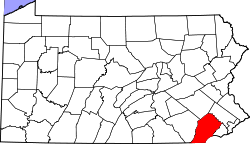Glenmoore, Pennsylvania | |
|---|---|
 Location in Chester County and the U.S. state of Pennsylvania | |
| Coordinates: 40°05′20″N75°46′19″W / 40.08889°N 75.77194°W | |
| Country | United States |
| State | Pennsylvania |
| County | Chester |
| Township | Wallace |
| Area | |
• Total | 12.1 sq mi (31 km2) |
| • Land | 12.0 sq mi (31 km2) |
| • Water | 0.1 sq mi (0.26 km2) |
| Elevation | 446 ft (136 m) |
| Time zone | UTC-5 (EST) |
| • Summer (DST) | UTC-4 (EDT) |
| ZIP code | 19343 [1] |
| Area codes | 610 and 484 |
Glenmoore is an unincorporated community that is located in Chester County, Pennsylvania in the United States. [2] It is part of the Philadelphia Metropolitan Area.
Contents
As of 2020, it had a population of 872. [3]





